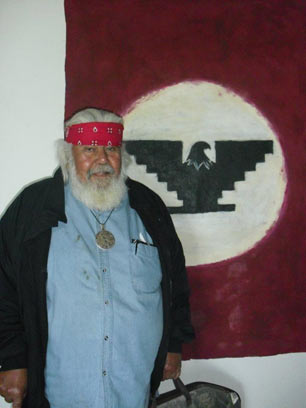Ce. Uno. One: First memories. Through his daughter Raquel, I meet Gustavo Gutierrez in 1992, who by then, is already a legend. In Arizona, his name is synonymous with workers, farm workers, Cesar Chavez, the United Farm Workers movement and the Arizona Farm Worker’s union. Had Cesar not lived, Gustavo would still have organized; he would have still fought for the rights of all workers, with or without documents. This is a man who is truly ahead of his time; before his time. Early on, he recognized the existence of no borders; Un Continente y Una Cultura.
Ome. Dos. Two: Despite all that history, he will most likely be remembered for his work with the Peace and Dignity Journeys. Born of the Prophesy of the Eagle and the Condor, the journeys continue to connect the continent. The Journeys were birthed in Quito, Ecuador at a 1990 gathering of indigenous peoples, convened to counteract the so-called 500-year encounter between Spain and the Americas. There was no encounter; instead there was invasion, land theft and slavery. All the peoples of the continent know this, understand this. Gustavo was no different; those that gathered in Quito, including him, would hear no talk of encounters.
 Yei. Tres. Three: There are no Americas; instead there is Abya Yalla, Pacha Mama and Turtle Island. There is no division; there are not two continents. Yet, there is the Eagle (north) and there is the Condor (south), and the Quetzal in the center brings them together in unity. That’s how Peace and Dignity was born in 1992. I am not qualified to tell that story, though I can offer a glimpse. Runners began in Alaska in the North and Tierra del Fuego, Argentina in the South and they met on October 11, in the ancient city of Teotihuacan (Where Lords are Legitimated). The historic journeys lasted half a year, going through and uniting Indigenous nations, reservations, pueblos, barrios and historic villages for the first time in many generations. Hundreds of thousands came to this ancient city also on that day, as they came to celebrate “the last day we were free.”
Yei. Tres. Three: There are no Americas; instead there is Abya Yalla, Pacha Mama and Turtle Island. There is no division; there are not two continents. Yet, there is the Eagle (north) and there is the Condor (south), and the Quetzal in the center brings them together in unity. That’s how Peace and Dignity was born in 1992. I am not qualified to tell that story, though I can offer a glimpse. Runners began in Alaska in the North and Tierra del Fuego, Argentina in the South and they met on October 11, in the ancient city of Teotihuacan (Where Lords are Legitimated). The historic journeys lasted half a year, going through and uniting Indigenous nations, reservations, pueblos, barrios and historic villages for the first time in many generations. Hundreds of thousands came to this ancient city also on that day, as they came to celebrate “the last day we were free.”
Nahui:. Cuatro. Four: Peace and Dignity represents the coming together of Indigenous peoples from the four directions – red, black, yellow and white – from all directions. Peace and Dignity represents creation as opposed to reaction. It represents truth as opposed to historical denial. It represents the idea that we cannot be foreigners on our own lands — that we can not be immigrants on our own continent. This was the message in 1992 and it is the message of 2012. Peace and Dignity has since been run every four years; this year, the run is dedicated to water and the runners will meet in Guatemala, in part, due to the astronomical significance of this year to the Maya.
Macuili. Cinco. Five: In his own words, in the 2005 origins and migrations documentaryAmoxtli San Ce Tojuan (We Are One), he says:
“And I told them, you know, I get tired of you guys talking about illegals. You guys have been here only 200 years. We’ve been here since time immemorial. My people have been here since time immemorial. I’m an Indian (Opata). And you guys call us illegals. We’ve been here… and we will continue to be here.”
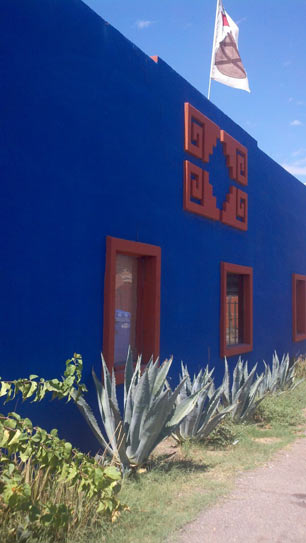 Chicuace. Seis. Six: Temoaya, Mexico. I have this memory of Gustavo in Mexico City in 1993. It was the day before the historic gathering of Indigenous peoples in Temoaya, Mexico – the ancestral grounds of the Otomi. This gathering was the follow-up to the 1990 Quito gathering, and a year after the first Peace and Dignity Journeys. On the day I saw him, he told us how he was bothered by divisions within the Indigenous movement, and so he took off his shoes, took deep breaths and placed tobacco on the ground. This was in the Zocalo, the historic part of Mexico City-Tenochtitlan. At this historic gathering at Temoaya, a contingent of Zapatistas showed up, a few months prior to the Jan. 1, 1994 uprising.
Chicuace. Seis. Six: Temoaya, Mexico. I have this memory of Gustavo in Mexico City in 1993. It was the day before the historic gathering of Indigenous peoples in Temoaya, Mexico – the ancestral grounds of the Otomi. This gathering was the follow-up to the 1990 Quito gathering, and a year after the first Peace and Dignity Journeys. On the day I saw him, he told us how he was bothered by divisions within the Indigenous movement, and so he took off his shoes, took deep breaths and placed tobacco on the ground. This was in the Zocalo, the historic part of Mexico City-Tenochtitlan. At this historic gathering at Temoaya, a contingent of Zapatistas showed up, a few months prior to the Jan. 1, 1994 uprising.
Chicome. Siete. Seven: Tonatierra, Phoenix. Akin to Peace and Dignity, the story of Tonatierra is not mine to tell. Only a glimpse. I only know that he and his wife Ricki (Raquel) were elders there. They were both well-respected and he was always present at all the important ceremonial functions. Tonatierra is an indigenous human rights organization; it has been instrumental and present at every international gathering of Indigenous peoples since 1990. It is one of the organizations that has been instrumental in including Chicanos/Chicanas in these historic gatherings, teaching them to see themselves not as unique, but as part of this red continent. Tonatierra is also the host of Nahuacalli: Embassy of Indigenous Peoples.
Chicueyi. Ocho. Eight: In the 20 years that I have known Gustavo, I have met his amazing family; his wife, and four daughters. Through the years, I’ve also had the honor and privilege of “working” with two of the daughters, Ramona and Anobel. At 80, he could no longer do the same work when he was a “joven de sesenta” (a young man of 60). It is those two sisters (along with many hundreds of volunteers) that continued the very difficult work of Peace and Dignity. And this story really can’t be put into the past tense because the 2012 Peace and Dignity Journeys continue.
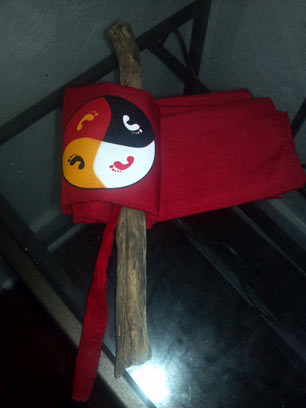 Chicnahui. Nueve. Nine: Kayenta to Keams Canyon, Arizona run. As human beings, we are a compilation of stories and memories. I have many fond memories of Gustavo and his family. Most of the latest stories and memories are about running. A few weeks ago, as I was seeing a chiropractor regarding my shoulder, she told me not to run anymore. Within an hour I received a message that Peace and Dignity needed runners to do the northern Arizona route. I ignored Gustavo’s message and a few other messages. Finally his daughter Ramona called and told me that it was important for me to run, because her father wanted me to run. She convinced me, shoulder or no shoulder. The 160-mile run, coordinated by Gustavo and Tucson’s Calpolli Teoxicalli, was most powerful, ending with a very moving ceremony before we headed back to Phoenix and Tucson. Had I not taken part in this run, perhaps my other memories would’ve faded and I would have remembered him differently. Because I ran for two friends, I will always remember this run in a most special way.
Chicnahui. Nueve. Nine: Kayenta to Keams Canyon, Arizona run. As human beings, we are a compilation of stories and memories. I have many fond memories of Gustavo and his family. Most of the latest stories and memories are about running. A few weeks ago, as I was seeing a chiropractor regarding my shoulder, she told me not to run anymore. Within an hour I received a message that Peace and Dignity needed runners to do the northern Arizona route. I ignored Gustavo’s message and a few other messages. Finally his daughter Ramona called and told me that it was important for me to run, because her father wanted me to run. She convinced me, shoulder or no shoulder. The 160-mile run, coordinated by Gustavo and Tucson’s Calpolli Teoxicalli, was most powerful, ending with a very moving ceremony before we headed back to Phoenix and Tucson. Had I not taken part in this run, perhaps my other memories would’ve faded and I would have remembered him differently. Because I ran for two friends, I will always remember this run in a most special way.
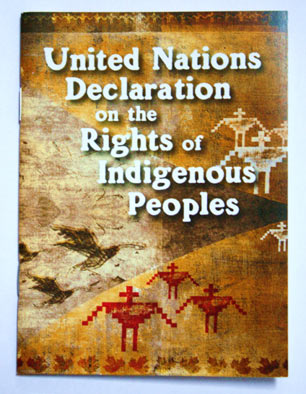 Matlactli. Diez. Ten: Gustavo’s passing. I did not intentionally inquire about the specific details of his death. What I do know is that after the ceremony, he went on to the bottom of the Grand Canyon, to continue on with the run. There, he took a fall while riding a horse. He was flown to a hospital in Flagstaff, where he remained several days before passing. That is the one thing I do regret; not visiting him while he was in the hospital. Yet his gift of two Peace and Dignity bandannas and the conversations I had with him on the run left me with good memories. If not for these memories, the last thing I would’ve remembered was speaking to him at Tonatierra, when we as a community ran to Phoenix (again), taking a long route (165 miles), in March of this year, in defense not just of Mexican American Studies, but of Indigenous Studies… as guaranteed by the 2007 UN Declaration on the Rights of Indigenous Peoples.
Matlactli. Diez. Ten: Gustavo’s passing. I did not intentionally inquire about the specific details of his death. What I do know is that after the ceremony, he went on to the bottom of the Grand Canyon, to continue on with the run. There, he took a fall while riding a horse. He was flown to a hospital in Flagstaff, where he remained several days before passing. That is the one thing I do regret; not visiting him while he was in the hospital. Yet his gift of two Peace and Dignity bandannas and the conversations I had with him on the run left me with good memories. If not for these memories, the last thing I would’ve remembered was speaking to him at Tonatierra, when we as a community ran to Phoenix (again), taking a long route (165 miles), in March of this year, in defense not just of Mexican American Studies, but of Indigenous Studies… as guaranteed by the 2007 UN Declaration on the Rights of Indigenous Peoples.
Matlactli Huan Ce. Once. Eleven: Even before I met him in 1992, I had known about him. One reason was because of an article I had written 10 years before that: “Who Declared War on the Word Chicano?” He had reprinted many thousands of copies and made them into a little booklet and distributed them everywhere. When I met him, I told him that I had to do a part two to that article. He shook his head and said there was no need; that it was perfect just the way it was. We “argued,” and the result was that five years later, I wrote what I referred to as an anti-book: The X in la Raza. It was a response to myself, and in effect, I wrote it because of Gustavo. My argument was that beyond race and culture, our spirit is our identity. That’s a good memory, and now, coincidentally, it’s a banned “anti-book.”
Matlactli Huan Ome. Doce. Twelve: Last memories. When we were told of Gustavo’s passing, we went to Guadalupe and Salt River in Arizona to honor him. Those memories included seeing people from everywhere, especially those that came from afar. Many of them were part of the Peace and Dignity Journeys. The reverence I observed is what I saw at the Cesar Chavez funeral in Delano and La Paz, Calif., some 20 years before. And yet this was different; most of those that came to honor Gustavo in the Yaqui village of Guadalupe were Indigenous peoples. So too at the all-night ceremony at Salt River. There, I saw people stream in continuously, honoring him in the way that they knew. I didn’t stay the entire night. I had seen enough and heard enough to know that he will not soon be forgotten.
Matlactli Huan Yei. Trece. Thirteen: How to honor him. Even though I’m not supposed to run anymore, I can’t think of another way of honoring Gustavo, but to run. And so rather than mourn, that’s what many of us have done since he has gone on to spirit world… we have followed his wishes by continuing the journeys. This past weekend, the journeys went into Mexico, 120 miles from Tucson to Magdalena, Sonora. His spirit was with us. Most of us returned, but the journeys are continuing on to Guatemala. One of our brothers from Tucson – Mazatl – has been on the journeys since the spring from the south, heading towards Guatemala. It appears another one of our runners from Tucson will also be continuing on the run in Mexico, to join up in Guatemala by late November. We will all honor him in the way that we can.
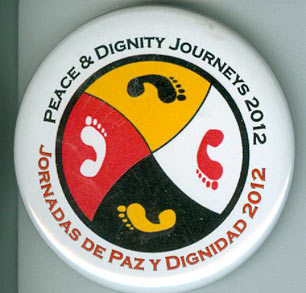 Last Thoughts: The Preferential Option for the Poor. I will always remember that when I first heard his name, I thought it was the scholar, the Peruvian liberation theologian of the same name who coined the term: “The preferential option for the poor.” In a way, they shared something in common, except that the liberation that Gustavo fought for was not an option; it is indigenous/human liberation, predicated on self-determination.
Last Thoughts: The Preferential Option for the Poor. I will always remember that when I first heard his name, I thought it was the scholar, the Peruvian liberation theologian of the same name who coined the term: “The preferential option for the poor.” In a way, they shared something in common, except that the liberation that Gustavo fought for was not an option; it is indigenous/human liberation, predicated on self-determination.
How will Gustavo be remembered? This is no cliché: by the huge footprints he left behind.
* The family has set up a Support Trust for Gustavo Gutierrez: Bank of America – 4570 2564 7444. For info re the Peace and Dignity Journeys, go to:https://eaglecondorproductions.weebly.com/support-the-2012-peace-and-dignity-journeys.html
UNTIL MIDNIGHT: All gifts to Truthout now matched!
Today all donations to Truthout will be matched dollar for dollar! Thanks to a generous supporter, your one-time gift today will be matched immediately. As well, your monthly donation will be matched for the whole first year, doubling your impact.
We have just one day left to reach our goals: raising $35,000 in one-time gifts and adding 450 new monthly donors.
This matching gift comes at a critical time. Trump has made it no secret that he is planning a demolition-style attack on both specific communities and democracy as a whole, beginning on his first day in office.
Help us prepare for Trump’s Day One, and have your donation matched today!
